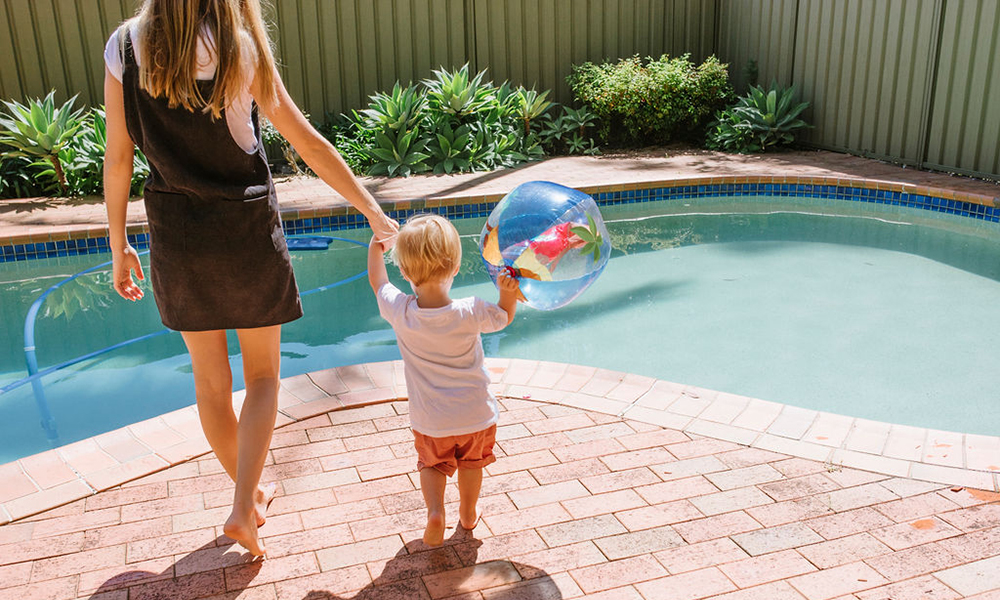
The home pool environment is often a place of fun and enjoyment. However, home pools are associated with a high risk of drowning, particularly for children aged 0 to 4 years.
Most children who drown in home pools fall in by accident. Children drown quickly and silently, often without making any noise or splashing. Young children are naturally curious and attracted to water but do not yet understand the concept of danger, while parents can become complacent about safety around a familiar home environment.
In cases of child drowning in home pools, designated supervisors were often distracted by everyday tasks, such as a conversation with another person, answering the door or attending to another child, all of which give a young child time to wander away unnoticed.
Children have commonly gained access to the pool area through a fence or gate which had fallen into disrepair, the lack of a fence or a gate which had been deliberately propped open.
When left in and around the pool, pool toys can attract the attention of children who may try to get through or over a fence or reach out to try and get the toy from the pool’s edge. For this reason, all pool toys need to be securely stored out of sight and reach of children and never left in the pool when not in use.
Strategies for the prevention of child drowning are well understood and include active adult supervision, restricting a child’s access to water (commonly using correctly installed and regularly maintained pool fencing), teaching children water safety skills and learning how to respond in case of an emergency.
How to keep your child safe at home
Keeping children safe around water constitutes following the four key actions of Royal Life Saving's Keep Watch Campaign:
- Supervise. Actively supervise children around water
- Restrict. Restrict children’s access to water
- Teach. Teach children water safety skills
- Respond. Learn how to respond in the case of an emergency
Children must be supervised by an adult when in, on or around water. Active supervision means focusing all of your attention on your child, all of the time. You must be within arms’ reach, interacting with your child and be ready to enter the water in case of an emergency. Our research shows that any distractions, such as using mobile phones or doing household chores, while children are near water increases their risk of drowning.
Restrict access to water by correctly installing and regularly maintaining a pool fence with a gate that self-closes and self-latches. Royal Life Saving’s home pool safety checklist can help. Remember to never prop the gate open.
All water bodies with a depth of 30cm or more need to be fenced in accordance with State or Territory legislation. This includes portable pools, such as inflatable and wading pools.
Securely store all pool toys out of sight and reach of children and never leave toys in the pool area when not in use.
Teaching children water safety skills is an important step in ensuring they grow up to become confident around water. Familiarise children with water by enrolling them in water awareness classes, spending time with them in the water and establishing basic water safety rules.
All parents are encouraged to learn cardiopulmonary resuscitation (CPR). Knowing how to respond in an emergency could mean the difference between life and death.
Other water safety considerations around the home
The backyard pool and spa are obvious drowning hazards but there are many other items and areas which present a drowning threat to young children around the home.
Children must be supervised whenever around water at home. Check your home for water dangers and consider all hazards such as buckets, open drains and water fountains. Basic water safety rules should be established for your children.
Buckets, bathtubs, eskies (coolers), water fountains and features, fishponds, drains, inflatable pools, water tanks and even pet bowls all pose a significant drowning risk especially to younger children. It is crucial that these are emptied, covered, put away and not left where they can fill up with water. Inflatable pools should be emptied after use and stored securely out of reach of children.
Most toddler drowning deaths occur when parents’ attention is divided. Everyday household tasks such as attending to other siblings, preparing meals, answering the front door and phone calls are just a few of the many distractions that can interfere with supervision.
Often at parties and gatherings people can assume that someone else is watching their child. In fact, it is possible that no one is supervising. Nominating a designated child supervisor during parties and gatherings is a way of ensuring that children are supervised at all times. A designated child supervisor should be chosen during parties and gatherings. This is an effective way of ensuring that children are supervised at all times. If this person needs to leave for any reason, ensure a new supervisor is appointed or regularly rotate the supervision responsibilities. If alcohol is being consumed, supervisors should be sober.
